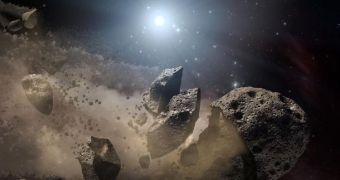The most recent investigations conducted with the NASA Wide-field Infrared Survey Explorer (WISE) spacecraft suggest that the family of asteroids which was widely believed to have been responsible for the extinction event that killed off all the dinosaurs is in fact innocent of all charges.
Dinosaurs were wiped from this Earth during and following the Cretaceous–Tertiary (K-T) extinction event, some 65 million years ago. At that time, a large asteroid is believed to have impacted the planet, causing a chain of events that destabilized all the ecosystems.
Losses to biodiversity and species numbers were massive, but the event set the stage for the rise of mammals, including our most distant ancestors. Without the K-T event – or another of similar scope and magnitude – the world would still be ruled by giant lizards.
For quite some time, investigators thought they had the family of asteroids that launched the perpetrator against Earth all figured out, but the extremely-sensitive WISE satellite proved otherwise. The observatory is about 1,000 times more sensitive in infrared wavelengths than other space telescopes.
Back in 2007, observations conducted in visible-light wavelengths from ground-based instruments revealed that the huge asteroid called Baptistina might have been responsible for the K-T extinction event. The space rock's remnants can still be found in the solar system today.
The theory that was developed around Baptistina held that the large asteroid crashed into another massive space rock inside the Inner Asteroid Belt, between the orbits of Mars and Jupiter. The debris – some as big as mountains – swept the inner, including Earth, in a wave of destruction.
“As a result of the WISE science team's investigation, the demise of the dinosaurs remains in the cold case files,” Lindley Johnson explains. He is the executive of the NASA Headquarters-based Near Earth Object (NEO) Observation Program.
“The original calculations with visible light estimated the size and reflectivity of the Baptistina family members, leading to estimates of their age, but we now know those estimates were off,” he adds.
“With infrared light, WISE was able to get a more accurate estimate, which throws the timing of the Baptistina theory into question,” the NASA official goes on to say. The WISE mission – which concluded this February – is managed by the NASA Jet Propulsion Laboratory (JPL), in Pasadena.
From October 2010 to February 2011, the extended segment of the mission, called NEOWISE, managed to catalog in excess of 157,000 asteroids in the IAB, and also discovered 33,000 new ones.
“We are working on creating an asteroid family tree of sorts. We are starting to refine our picture of how the asteroids in the main belt smashed together and mixed up,” JPL researcher and lead study author Joseph Masiero concludes.

 14 DAY TRIAL //
14 DAY TRIAL //